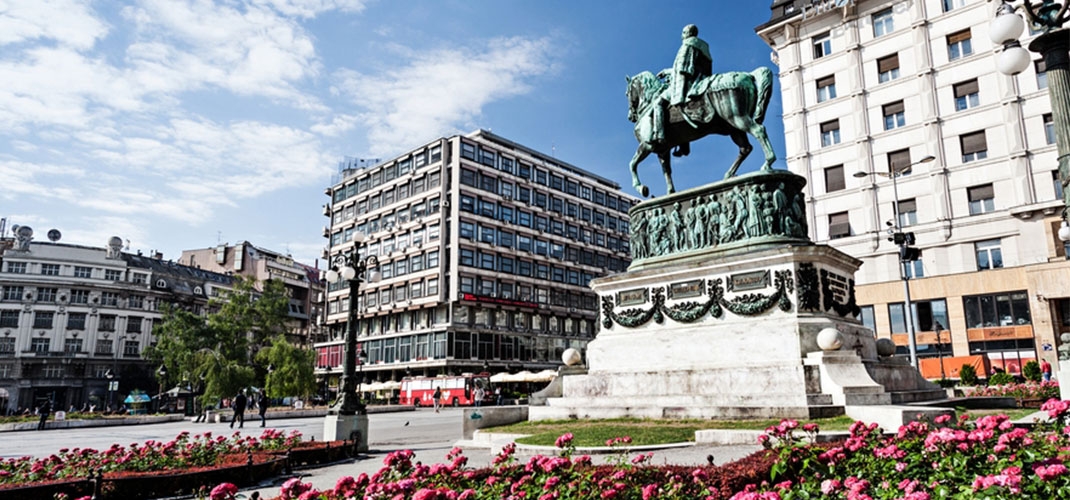Serbia

Serbia is a country of energetic urban cities to peaceful towns and villages that dot its magnificent countryside with a wealth of cultural and historic attractions to enjoy.
Serbia’s Capital Belgrade is located at the crossroads between the Danube and the Sava Rivers and is an eclectic mix of old and new styles, from 19th Century buildings to Art Nouveau buildings. The city’s most popular attraction is the Kalemegdan Fortress located in Kalemegdan Park, which overlooking the Sava and Danube Rivers. The park is also home to the Military Museum that features the remnants of a US Stealth Bomber. Another major site is the largest and most recognisable Orthodox Church, the Church of Saint Sava, which dominates the city’s skyline at a height of 79 metres.
Besides the main attractions, the colourful façades and quaint squares why not head out to the Island of Ada Cinganlija or ‘Gypsy Island’ in the south of Belgrade with its self-styled beach resort. Here you will find beaches that stretch along the banks of the Sava, where you can swim or do water sports like water skiing. Alternatively head to Belgrade’s Bohemian Quarter of Skadarlija where you will find a blend of high culture and a real zest for life with plenty of restaurants, cafés and bars that line the cobblestone streets.
The region of Vinca is situated just outside of Belgrade and is one of the most important places in Serbian history. Home to the archaeological site Belo brdo, meaning ‘White Hill’, the region was made famous by the archaeological finds uncovered in Vinca, many made of stone or bone, including statues, ornaments, and drinking vessels and where visitors can tour the site as well as the Museum showcasing examples of Neolithic culture that are said to date back approximately 5,000 to 4,000 B.C.
Novi Sad is the second largest city in Serbia and it is most famous for its dominating Petrovaradin Fortress, a protected building that dates back to the 17th Century. With many picturesque locations in the city including the Varadin Bridge that spans the Danube, there are also river cruises to take in the city from the water. For history buffs then a visit to the Stari Grad area of the city is where you will find War Memorials, Museums and Art Galleries as well as many cafés and bars.
Subotica is overflowing with Art Nouveau Halls and Palaces dating from the 20th Century. The Subotica City Hall is the biggest drawcard with its 45 metre Tower, however there is also the Art Nouveau Subotica Synagogue, the 18th Century St. Theresa of Avila Cathedral, Trg Slobode (Freedom Square) and the Franciscan Church to visit here. On the outskirts of the city, you will find vineyards in Palić as well as great some gastronomy in the region.
Niš, is a University town and the birthplace of the Roman Emperor Constantine. This city has a fun loving vibe as well as a number of attractions of historical importance, not least the Memorial of Constantine the Great, proudly on show in the centre of the city and the 18th Century Niš Fortress.
The Zlatar Mountain Range, crowned by the highest peak of Golo brdo, is full of meadows, lakes and forests, with its elevation and fresh air making is a great spa location. During the winter months, you can enjoy winter sports including skiing on the many slopes accessible via a dedicated ski lift that provides stunning views over the lush valleys beneath. The area also has three artificial lakes, which offer rafting, boating and fishing. There are also a number of picturesque wooden Churches and Monasteries that are scattered around the countryside.
Neighbouring Croatia in the Syrmia region, the Fruška Gora Mountain is affectionately known as the ‘Jewel of Serbia’. The region is not only scenic it also includes the protected Fruška Gora Park, which is dotted with vineyards and wineries. There is so much to do here including hiking and climbing but its biggest drawcard besides the wineries are the Orthodox Monasteries that are spread across the countryside, some dating back to the 12th Century.
Sokobanja in East Serbia is a known as a spa town, once the retreat of choice of Roman Emperors. Both locals and celebrities flock here for the thermal waters that are said to have deeply healing properties and there is a public ‘hammam’ or steam room that dates back to the 17th Century. As well as the hot springs, visitors also enjoy the crisp air said to be high in negative ions and free from air pollution due to the increased elevation.
If winter sports are your thing, then Kopaonik is the place to visit during the winter months. The Kopaonik Mountain is where you can hit the slopes whatever your level of ability. With twenty four ski lifts that service the area and a range of slope categories for all levels as well as skiing and snowboarding available at the Kopaonik Ski Resort. In the summer months the area is great for the adventurous who like to go hiking or mountain climbing.
Other places to visit in Serbia include Mokra Gora, situated in a lush valley with a spectacular landscape. The village has been restored and reminds you of days gone by. Close by to Mokra Gora is Sirogojno a quaint village that includes an Open-Air Museum or self-styled ‘Ethnic village’ that includes period timbre structures including a traditional Serbian dairy, bakery and an inn. The locals are available to demonstrate their traditional arts and crafts from the region and it is also a fantastic place to sample the local cuisine with traditional Serbian dishes or to try the local ‘Rakija’, a Serbian brandy.
Filter Results
Trip Duration
Price Range
Country Destinations
Select Countries to Visit
City Destinations
Select Cities to Visit
Tour Categories
Select a Tour Category
Filter Results
Trip Duration
Price Range
Country Destinations
Select Countries to Visit
City Destinations
Select Cities to Visit
Tour Categories
Select a Tour Category
